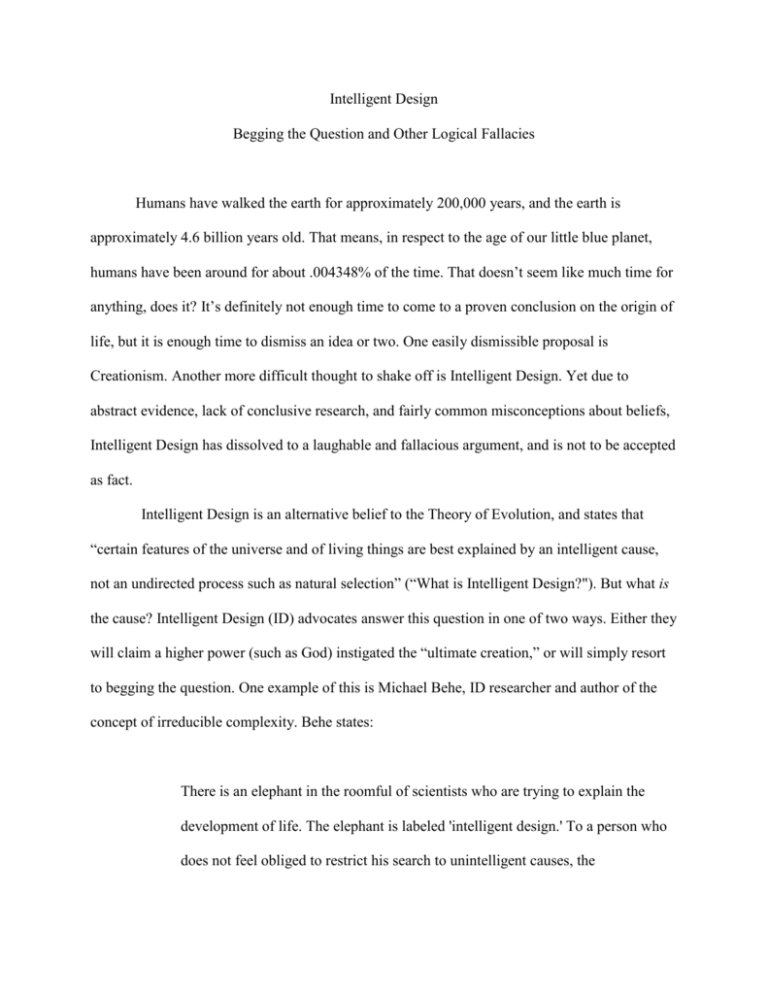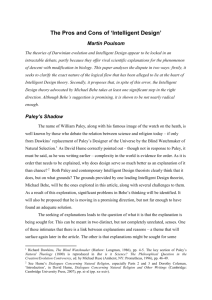Intelligent Design
advertisement

Intelligent Design Begging the Question and Other Logical Fallacies Humans have walked the earth for approximately 200,000 years, and the earth is approximately 4.6 billion years old. That means, in respect to the age of our little blue planet, humans have been around for about .004348% of the time. That doesn’t seem like much time for anything, does it? It’s definitely not enough time to come to a proven conclusion on the origin of life, but it is enough time to dismiss an idea or two. One easily dismissible proposal is Creationism. Another more difficult thought to shake off is Intelligent Design. Yet due to abstract evidence, lack of conclusive research, and fairly common misconceptions about beliefs, Intelligent Design has dissolved to a laughable and fallacious argument, and is not to be accepted as fact. Intelligent Design is an alternative belief to the Theory of Evolution, and states that “certain features of the universe and of living things are best explained by an intelligent cause, not an undirected process such as natural selection” (“What is Intelligent Design?"). But what is the cause? Intelligent Design (ID) advocates answer this question in one of two ways. Either they will claim a higher power (such as God) instigated the “ultimate creation,” or will simply resort to begging the question. One example of this is Michael Behe, ID researcher and author of the concept of irreducible complexity. Behe states: There is an elephant in the roomful of scientists who are trying to explain the development of life. The elephant is labeled 'intelligent design.' To a person who does not feel obliged to restrict his search to unintelligent causes, the straightforward conclusion is that many biochemical systems were designed. They were designed not by the laws of nature, not by chance and necessity; rather they were planned. The designer knew what the systems would look like when they were completed, then took steps to bring the systems about. Life on earth at its most fundamental level, in its most critical components, is the product of intelligent activity. (Behe 193) Behe offers “absolutely no general laws, no models, no explanation how design happens, no testable predictions, no way to falsify his hypotheses, and no way to detect design.” (Killer Argument) Here rests a perfect example of the Burden of Proof fallacy, another common name for this is, fittingly, appeal to ignorance (“Fallacies”). He never takes so much as a guess as to who or what exactly this designer was (Catalano), because if he did, he’d be claiming that Creationism is in fact the “cause” and the burden of proving it would be on his shoulders. ID proponents try to avoid “claiming Creationist” so as to separate themselves from those who “focus on defending a literal reading of the Genesis account” (West). So, Behe chooses the lesser of two evils, and settles for the latter of the two arguments which “is fallacious[,] because simply assuming that the conclusion is true… does not constitute evidence for that conclusion.” (“Fallacies”) In other words, no new information is provided to validate the claim; it’s a circular argument that is unsupported by technical research papers, scientific theory, or the like (Catalano). While attempting to compete with Darwinist Evolution by presenting themselves as a scientific theory, ID supporters are succeeding in separating themselves from Creationists, yet the fundamental aspect of the argument which they strive to defend is becoming more and more transparent as it is shot full of holes by evolution proponents, and literary analysts alike. The “undirected” process, by which evolution is believed to have occurred, is known as natural selection. Natural selection is the preservation of a functional advantage that enables a species to compete better in the wild (Darwin’s Theory of Evolution). Is this truly undirected? That depends on the perceptive lenses you wear. In the same way the Supreme Court interprets the Constitution, one may interpret this definition literally, or evolutionary (Ironic, isn’t it?). By literal interpretation, yes, the process is undirected because there is “no structured plan or guide” (Merriam-Webster). However, if the goal of a species is to survive in their environment (Darwin), carrying on favorable traits in order to strengthen the future generations of the species is not only very necessary, but a fairly solid game plan. Of course, this strengthening of the species is an incredibly slow process. The variations in the genes must only vary slightly from the “normal” genes, or the carrier could be burdened by the trait, versus ideally benefiting from it. For instance, the primitive species which would later become the giraffe, Helladotherium, did not have the extremely elongated neck we find in the species today. Had an offspring of the primitive animal been born with such an exaggerated neck, the larynx, pharynx, esophagus, and several other vital organs would have been weakened to the point of being utterly dysfunctional, and the offspring would have perished. Thus, eliminating (or at least minimizing) the continuation of the unfavorable variation in the gene (Grandin & Deesing). Natural selection must be gradual in order to be successful, and Darwin conceded that “If it could be demonstrated that any complex organ existed, which could not possibly have been formed by numerous, successive, slight modifications, my theory would absolutely break down." (Darwin & Darwin’s Theory of Evolution) (Fig. 1 Helladotherium) Helladotherium was a primitive giraffe, a member of the Sivatheriinae subfamily of the Giraffidae family. “With this statement, Charles Darwin provided a criterion by which his theory of evolution could be falsified” (“Irreducible Complexity”). A favorite argument ID supporters produce against Darwinist Evolution is a concept called irreducible complexity. Michael Behe attempts to prove the flaw that would demoralize the theory of evolution using this concept, and it has been mildly successful in capturing the attention of those who lack a scientific background. Behe uses the example of a mousetrap. A simple structure that requires all parts to provide a function, i.e. catch mice. Without the platform, there would be nothing to hold the pieces together, the structure cannot function. Without the holding bar, the hammer would not stay cocked, the structure will not function, etc. (Carroll). Behe claims this structure cannot come about in a gradual manner; that “all the components must be in place before [the structure] functions at all” (“Irreducible Complexity”). However he attempts to prove a flaw not knowing (or at least not acknowledging) his own argument is in fact flawed. Here, Behe has fallen victim to yet another fallacy, this time it’s Questionable Cause. This fallacy involves “drawing the conclusion that A is the cause of B simply because A and B are in regular conjunction… The mistake being made is that the causal conclusion is being drawn without adequate justification.” (“Fallacies”) Behe tries simply ignore the fact that evolution does not just add components in a gradual manner, as we’ve discussed, but that it also changes and removes parts through variation and elimination. On a related note, nearly a century ago Nobel Prize winner H. J. Muller predicted, described, and explained, using evolutionary theory, that irreducibly complex systems can evolve by direct, gradual evolutionary mechanisms (Theobald). There are at least three different ways that an irreducibly complex system can be produced by a series of small modifications: Improvements become necessities, loss of scaffolding, and duplication and divergence (Catalano). “After [adding a part, and making it necessary], removing the part will kill the function, yet the system was produced directly and gradually from a simpler, functional precursor” (Theobald). This is known as The Mullerian Two-Step, after Nobel Prize winning geneticist Hermann Joseph Muller. In his 1939 research of so called “irreducible complexity” Muller stated: An embryological or physiological process or structure newly arisen by gene mutation, after becoming once established (with or without the aid of selection), later takes more and more part in the whole complex interplay of vital processes. For still further mutations that arise are now allowed to stay if only they work in harmony with all genes that are already present, and, of these further mutations, some will naturally depend, for their proper working, on the new process or structure under consideration. Being thus finally woven, as it were, into the most intimate fabric of the organism, the once novel character can no longer be withdrawn with impunity, and may have become vitally necessary. (“Creationist Fallacy”) Thereby providing a basis for what we call today; add a part make it necessary. The most common example of this is the stone bride anecdote, wherein three stones are used to create a functional structure, a bridge. A long, flat stone is then added on top of the structure to make it more efficient, ergo the bridge has been improved. Note, the structure remains functional. Finally, the center stone may be removed, and the function of the structure is not damaged. The structure is now irreducibly complex, because the top stone (which was added) is now necessary for the function of said bridge. Three stones laid side by side create a bridge. A flat stone is laid on top to make the bridge more efficient. The center stone is removed, and the bridge still functions. It is now irreducibly complex through evolutionary process. (Fig. 2) The Mullerian Two-Step (Theobald & “Creationist Fallacy”) The loss of scaffolding in the Mullerian Two-Step example would be found in the removal of the third stone, i.e the scaffold or “temporary platform” (“Scaffold”). For duplication and divergence, a gene is simply copied then, the two copies are free to diverge (to mutate and become different). The aim of this is for one of the diverged copies to become beneficial. If they do not, the carrier of the harmful gene will be eliminated, and with it, the gene. This is explained to appear as a reasonably simple process, yet according to Susumo Ohno, an icon in the literature on genome evolution, it is “the single most important factor in evolution.. [because] without duplicated genes[,] the creation of metazoans, vertebrates, and mammals from unicellular organisms would have been impossible.” (Taylor, Raes) As shown in Figure 3, duplication and divergence may well be the reason humans do not have gills, feathers, or webbed feet. (Fig. 3) Example of Duplication and Divergence (“Evolution of thermoTRP”) Due to arguments such as the Muller Two-Step, ID supporters have begun to play the numbers game rather than dismiss all potential held by the evolutionary theory. Many a point has been made that the odds against DNA randomly assembling are 10^40,000 to 1 (Stenger). According to Stenger, an American particle physicist; “This is true, but highly misleading. DNA did not assemble purely by chance. It assembled by a combination of chance and the laws of physics… The nuclear force was needed to bind protons and neutrons in the nuclei of atoms; electromagnetism was needed to keep atoms and molecules together; and gravity was needed to keep the resulting ingredients for life stuck to the surface of the earth” (Carroll, Demme, & Sarfati) The odds against all four players in a game of bridge drawing 13 cards in the same suit are 2,235,197,406,895,366,368,301,559,991 to 1 but on April 15th, 1963, it happened (Bingham). In the words of John Palous, “It would be absurd for someone to be dealt a hand, examine it carefully, calculate that the probability of getting it is less than one in 600 billion, and then conclude that he must not have been dealt that very hand because it is so very improbable” (Carroll). Intelligent Design is a theory that is still in the developmental stages, but so is the Theory of Evolution. The difference between the two is evolution offers testable hypotheses, suggests an origin from which life arose, and uses processes that have been deemed scientific law. Evolutionary process is gradual, yet steadfast in the theoretical evaluation of the origin of life. ID theory is narrowly focused and attempts to discredit widely accepted beliefs without offering any viable information. It is abstract, unsupported, and tremendously fallacious.











